
Choosing the right balance bike for your little rider should be a fun, stress free experience.
Not only will this bring a smile to the little owner’s dial, but in addition will provide amazing social, emotional and physical rewards that are truly remarkable and of course, countless hours of fun to boot!
You are about to provide a wonderful gift that we here at ilovetoridemybike.com like to refer to as a developmental powerhouse on wheels.
These tiny little toys are capable of making huge developmental benefits for their little rider’s as they learn to ride a bike. But not all balance bikes are suited to every little riding champion.
Therefore, its super important for us adults to do our due diligence and complete our homework by checking out the best suited balance bike for our child before we invest in such a wonderful toy.
This is where our latest article steps up to the saddle.
In this article, we wish to empower you with all the know-how you will need before buying a balance bike for your child.
We call this our Balance Bike Buyers Guide and after finishing reading our article you will have the following balance bike expertise added to your inventory of knowledge;
- What exactly is a balance bike, what determines balance bike sizes and why is this important
- How to find your child’s inseam and seat height
- How to use your child’s seat height to go balance bike shopping
- Additional balance bike features to consider, and
- Overall summary and conclusion
As you can see, there is a lot of great information to share so as is our custom, we invite you to kick-back with your favorite means of hydration and enjoy our Balance Bike Buyers Guide.
*** Affiliate disclosure time: Some of the links on this page are affiliate links. If you click on those links and make a purchase within a time frame, we earn a small commission. Rest assured, the commission is paid by the retailers, not by you.
This commission helps keep ilovetoridemybike.com riding and writing. We thank you for your generous support. You are helping us continue doing what we love and that’s providing our customers with all the information they need to know about kids balance bikes.
What Exactly is a Balance Bike, What Determines a Balance Bike’s Size and Why is This Important?
What Exactly is a Balance Bike?
Balance bikes can simply be seen as a child’s first bike that have no pedals, no chain and no drivetrain. Balance bikes are the best means of teaching a child how to ride a bike, above and beyond any experience a tricycle can provide.
A balance bike first and foremost teaches balance. Balance is what is required when riding a pedal bike as the child will be providing the power for movement through the pedals and drivetrain.
Without the correct motor patterns being developed first, this pedal bike experience will be tricky, awkward and at best cumbersome to learn.

Balance bikes provide the unique means to develop the skills of balance, gross and fine motor control, fitness and bike handling on a safe, feet powered little toy that after a few years, will have the little rider gliding along effortlessly with their feet either on footrests or up in a resting position as they balance and glide majestically along.
This makes the transition to a pedal bike very simple, effortless and smooth. Now that is a brilliant result!
What determines a balance bikes size and why is this important?
Balance bikes generally come in just three sizes. These are called 12″, 14″ or 16″. These sizes are referring to the wheel size, or more accurately, the inside diameter of the wheel.
It is important to note here, that there are NO generic or standard balance bike sizes.
Manufacturers generally provide multiple pieces of sizing information for buyers (see images below of the Strider 12 Sport (USA) or (AUS) for an example), These may include;
- wheel size
- bike weight or maximum weight of rider
- age-range, and
- seat-height range

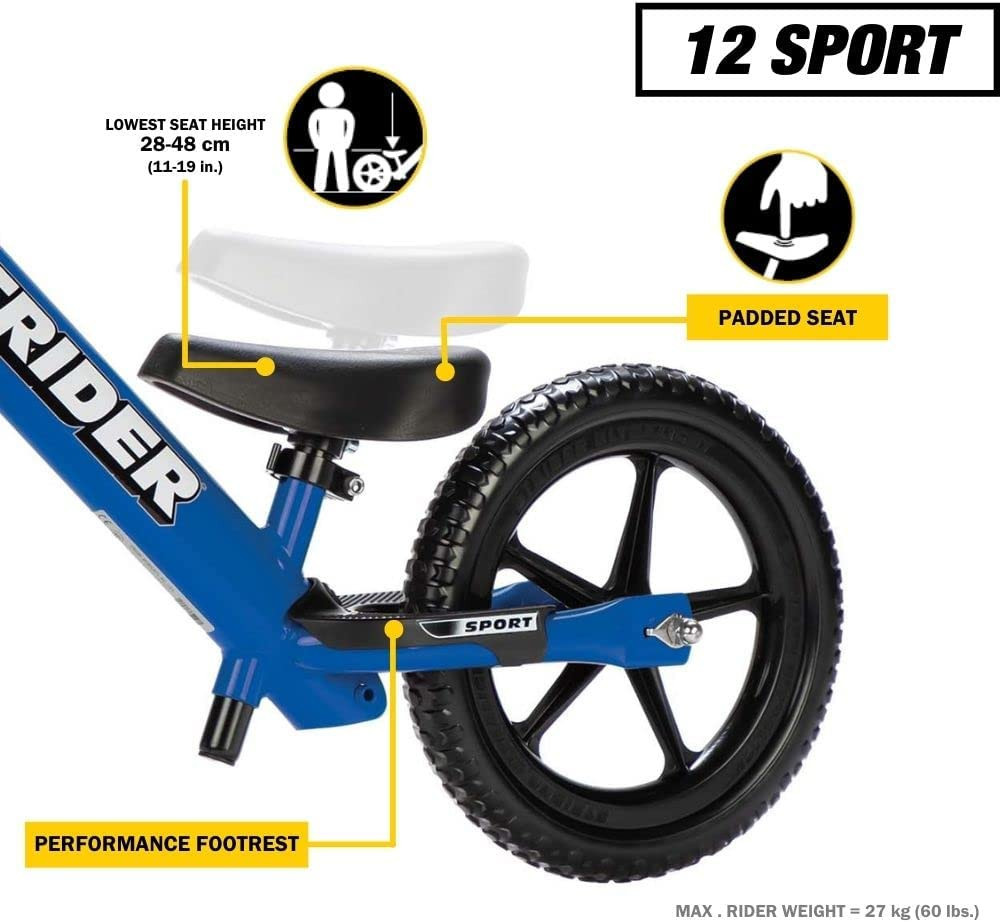
It is then up to the buyers to correctly use this information and find a suitable balance bike for their child. But, as we have already mentioned, NOT all balance bikes are suited for every rider.
Let’s get right to the point here, these size metrics are not a suitable means of finding the right size balance bike for your child until, you have one key piece of information.
So, we are going to keep this really simple and teach you the one key piece of information that you do need so that you can go balance bike shopping with confidence and correctly match the right bike to your riding champion.
That key piece of information is your child’s inseam height and optimal seat height!
There are additional features and specifications mentioned below that we encourage you to check out, just to make sure of the bike’s suitability. However, inseam height is #1 as this allows you to find your child’s optimal seat-height.
The optimal seat-height is the most important piece of information for determining which balance bike to buy because fitting your child to the right size bike will, quite simply, do wonders for their riding confidence, learning and overall fun!
How to find your child’s inseam and correct seat height
To find your child’s inseam height, check out our post Balance Bike Set-up Guide which will provide you with all the details to determine your child’s inseam height, how to use this to find the correct seat-height and also how to make the mechanical adjustments to your child’s balance bike.
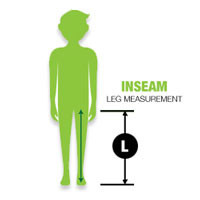 Once you have measured your child’s inseam, the correct seat-height is found by subtracting 1″ from this measurement. For example, if your child’s inseam height is 14″, their correct seat height would be 13″.
Once you have measured your child’s inseam, the correct seat-height is found by subtracting 1″ from this measurement. For example, if your child’s inseam height is 14″, their correct seat height would be 13″.
Therefore, the best seat-height range for your child would be between 13″ and 15″ (+2″).
Now here comes the fun part.
You now have the single most important piece of information you need to go balance bike shopping.
We will use this technically determined seat-height range and match this with a balance bike that best suits your little rider.
Let’s get riding (or maybe shopping).
How to use your child’s seat height to go balance bike shopping
Armed with this pretty groovy piece of technical knowledge, we can happily go searching for balance bikes that will best suit your rider.
Here is a step-by-step method to go balance bike shopping;
- first, check the manufacturers seat-height range via their website
- using your child’s optimal seat-height, make sure this fits within the bikes seat-height range
- in addition, we recommend that you check the manufacturer’s age-range recommendation, and
- check that the manufacturer’s balance bike weight is no more than 25-30% of your child’s weight
The wheel size should naturally align with the seat-height range and the age-range recommendation.
For example, a 12″-wheel size should be recommended for younger riders between 18 months to 5 years. Where 16″-wheel balance bikes should be recommended for older kids from 5 to 9 years.

That being said, the most common wheel sizes for balance bikes fall in the 12″ and 14″ size range.
Here is an example of using a child’s inseam and optimal seat-height, to look at suitable options of balance bikes to purchase.
Remember, we simply want your child’s optimal seat-height to fall within the balance bikes seat height range and for there to be at least 2″ of adjustment above their optimal seat height.
Let’s take a look at an example for a child with inseam height of 13 1/2″ and therefore optimal seat-height of 12 1/2″ (-1″).
Example Little Rider’s Details
Age: 3 years
Weight: 13.9kgs, therefore balance bike weight should be no more than 4.2kgs (30% of rider’s weight)
Inseam: 13 1/2″, therefore Optimal Seat-Height = 12 1/2″ (-1″)
| Balance Bike | Seat-Ht Range | Age-Range | Weight | Suitable Bike
Yes / No |
| Strider 12 Sport (USA) or (AUS) | 11 – 19” | 18 mth – 5yrs | 3kgs | Yes |
| Cruzee (AUS) | 11 – 19” | 18 mth – 5yrs | 1.9kgs | Yes |
| Chillafish (USA) | 11 – 14” | 18 mth – 4yrs | 2.5kgs | Yes |
| Strider 14X (USA) or (AUS) | 15 – 22” | 3 – 7 years | 5.7kgs | No |
| Banana GT (USA) or (AUS) | 12.5 – 17.5” | 2 – 4 years | 3.7kgs | Yes |
| Kriddo (USA) or (AUS) | 11 – 17” | 18 mth – 5yrs | 3.6kgs | Yes |
| GOMO (USA) or (AUS) | 12 – 17.5” | 18 mth – 5yrs | 3.2kgs | Yes |
| Bixe 16 (USA) or (AUS) | 18.5 – 20” | 5 – 9 years | 6.8kgs | No |
| Zoomy (AUS) | 11 – 17” | 18 mth – 4yrs | 2 kgs | Yes |
| Lava Sport (USA) or (AUS) | 12.2-16.1” | 2-5 years | 2.9kgs | Yes |
You can easily see from the table above, that for a 3-year-old, whose weight is 13.9kgs and optimal seat-height of 12 1/2″, that there are several options available. But just as importantly, we can see which bikes are not suited.
Luckily for us, we have the right information at hand and can easily discern the intricacies of the world of balance bike sizing with confidence and ease.
Additional Balance Bike Features to Consider
Having ridden into the vast realms of balance bike sizing and now being armed with the knowledge to confidently go balance bike shopping for your child, we will briefly mention some other features worth considering when looking at kids balance bikes.
As mentioned, we won’t be going into great depth here regarding the nuances of balance bike features, however please head over to our post What are the best balance bikes for kids 2022? We review the top 5, as this article provides an in-depth buyers guide that gives more insight, depth and clarity into the features we are briefly mentioning below.
So, what other features (apart from seat-height) are important on a kids balance bike? Great question.
Additional key features worth considering include the following;
- frame materials
- tires
- brakes
- weight
- footrests, and
- steering limiters
Frame materials
Balance bike frames are generally made from either steel, aluminium, non-plastic composite, wood or bamboo.
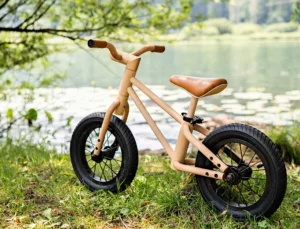 Each material has its advantages and disadvantages, however each serves a unique purpose and therefore has been made with the best material to suit that purpose.
Each material has its advantages and disadvantages, however each serves a unique purpose and therefore has been made with the best material to suit that purpose.
Also, each material being different, will be better suited for certain riders.
Every child is unique, therefore certain frame materials will be best suited to their needs. For example, aluminium is super-light and is better suited for smaller, less adventurous riders. Bamboo or wooden bikes have an environmental advantage due to their sustainability qualities.
Therefore, we always recommend matching the frame material to your unique little rider to ensure they have the best toy for the job of helping them learn how to ride a bike.
Tires
You have two choices here, air or tubeless. The tubeless tires are puncture proof and therefore very user-friendly.
Example of puncture-proof tire (USA) or (AUS)
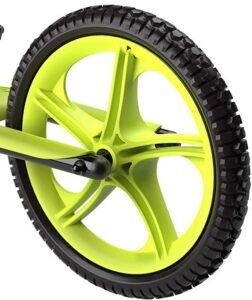
Air tires, however, provide the best in comfort due to their suspension qualities. Therefore, air tires make for a more enjoyable ride, absorbing shock and rolling over all forms of terrain much better than tubeless tire options.
Example of air-tire (USA) or (AUS)
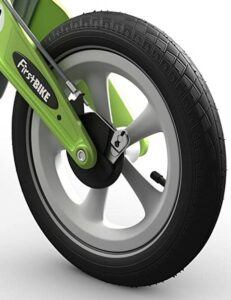
You will also find tires with varying treads and widths.
Generally, an all-terrain, air tire with greater width will be a heavier and more expensive option, such as those on the FirstBike Cross. The tubeless, more narrow and simple tread tires, like those you will find on a more budget-friendly balance bike such as the GOMO, will be lighter, cheaper and not handle off-road riding surfaces so well.
Once again, we recommend you look for the features that best suit your child and match the bike accordingly.
Brakes

Many balance bikes don’t include brakes and there is some conjecture as to whether they are really necessary.
We do recommend purchasing a balance bike with brakes if this is within your budget, such as those provided on the smarTrike 3-in-1 Xtend shown in the image below.
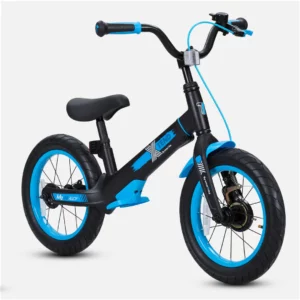 By doing so, you will be providing your little rider with the opportunity to fast track this very important skill of learning how to use a hand brake. The fine motor skills, coordination and physical development inherent to riding a bike will only be enhanced by learning how to safely use a brake while riding a balance bike.
By doing so, you will be providing your little rider with the opportunity to fast track this very important skill of learning how to use a hand brake. The fine motor skills, coordination and physical development inherent to riding a bike will only be enhanced by learning how to safely use a brake while riding a balance bike.
In addition, this will make for an even smoother future transition to a pedal bike that has brakes.
Weight
We have briefly touched upon a key piece of information regarding balance bike weight.
That is, be sure the bike weighs no more than 25-30% of your child’s weight. The reasoning behind this is straight forward. Even thou your child is tiny and nimble, just like most balance bikes, all weight is relative.
A balance bike needs to be really light so that it can best accommodate its little rider beautifully in helping them to propel themselves forward using their feet and control their bike effortlessly.
Essentially, a balance bike should help them learn how to ride a bike with ease. No wrestle, no struggle, just the challenge of learning the ultimate skills of balance and those innate to bike riding.
Footrests
Footrests are another feature that not all balance bikes have, as these are non-essential.
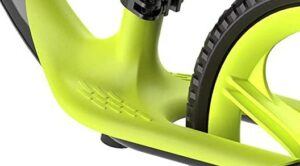 For those bikes with footrests, such as those found on the GOMO (see image), these are meant to provide a nice little platform for the rider to rest their feet when gliding.
For those bikes with footrests, such as those found on the GOMO (see image), these are meant to provide a nice little platform for the rider to rest their feet when gliding.
Some balance bikes, however, have poorly designed footrests that can interfere with the rider’s walking and stride.
These have been poorly designed and are positioned too far forward on the bikes frame.
Better, well-positioned footrests are featured further back, almost in line with the balance bike seat when looking directly down over the bike. These do provide a great platform for more experienced riders.
That being said, kids intuitively learn to raise their feet up and out of the way when gliding. Ultimately, we believe footrests are not an essential item to be looking for when deciding on which balance bike to purchase.
Steering Limiters
Steering limiter’s fall under the same umbrella of conjecture. Are they really needed?
A steering limiter is designed to limit the steering angle available on a bike. That is, to prevent over steering or what is often referred to as jackknifing.
If this occurs during riding, it creates a sharp turn of the handlebars and of course contributes to an abrupt halt. The end result being a crash.
A great example of a well-designed steering limiter – see Firstbike (USA) or (AUS)
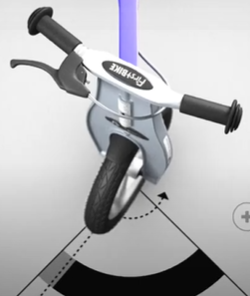
Some limiters are too restrictive on the range of steering available to the rider and are best avoided. Yet some, such as a rubber, removable steering limiter found on balance bikes such as the Woom 1 provide gentle correction and are able to be easily removed when the rider is more experienced.
In sum, to answer the question are steering limiters really needed? The short answer is no.
Like all features there will be advantages and disadvantages that are particular to your unique little rider’s needs. We believe these are not necessary and should not be a factor in determining your choice of balance bike for your child.
Overall summary and conclusion
We hope you have found are article helpful and that you now feel empowered and confident in being able to go balance bike shopping for your child.
In sum, you are now aware of the following technical balance bike know-how.
- what a balance bike is, what determines its size and why this is important to knowledge
- how to find your child’s inseam and optimal seat-height
- how to use this information to go balance bike shopping for the right size bike for your child, and
- some additional balance bike features to consider before making your purchase
If you have any questions or comments related to this article, or anything to do with the world of balance bikes please leave these below, as we love to hear from you and are happy to help.
Ride safe, have fun!

Choose the perfect balance bike for your little one with the Balance Bike Buyers Guide – an invaluable resource that provides all the details and advice necessary to make an educated decision. From understanding what a balance bike is, familiarizing yourself with its features and essential safety-conscious considerations to learning about the various materials bikes are made from and how each impacts weight and stability – this guide does it all! There’s even a helpful breakdown for choosing the right size for your child . Nature intended us to have balance, so why not arm them with the proper tools to nurture this gift? With this comprehensive guide, finding the ideal balance bike turns from a dreaded chore into a stress-free adventure.
Hi, thank you for your comments. Yes, we hope to have provided a simple, yet comprehensive guide to eliminate any misunderstandings when going shopping for a balance bike. They are a wonderful toy, but it is essential to get the right bike for the right rider. If you have any questions regarding anything to do with balance bikes, please contact us. Happy riding
I love the idea of a balance bike for kids as they can feel like they have total control of the bike, as they simply put their feet down before they can fall. Thank you for all the pointers you have provide when looking for a balance bike. I would definitely go for the tubeless version as my pet hate is fixing punctures. And maybe you are right, brakes are definitely a safer option.
Hi Michel, thank you for your comments. Yes, puncture-proof tires, such as those on the Strider 12 Sport, are really user-friendly, and to be honest, do a great job for most little rider’s. The brake’s are really a personal preference but if your child is outgoing, adventurous and a little fearless, then brake’s would definitely be recommended. This will slow them down and help keep them safer as they learn to control their abilities on a bike. Happy riding!
This site has all the information one needs to choose a balance bike for a Little One, plus advice on features… I enjoyed the clear, organized and logical presentation of the material, keeping it simple to implement, and thoroughly covering accessory points. This has made my project easier to realize, as a good parent, and I sincerely thank you for the help provided! My Little One can’t wait to see the outcome!
Hi, I’m so glad that you enjoyed our article and have found this useful.
Yes, I can share in being a new parent also, we have just introduced our little girl to her first balance bike, the Cruzee Ultralight and are very happy with this bike.
A wonderful benefit is that I can use my learnings and experiences to help share greater insights with everyone as she grows. Just like you, I cannot wait to see the results just as much as her. Thank you for following and your comments. If you have any questions please send them through, we are here to help you.
Hey a great post!
This was certainly interesting to read as firstly I was unaware of what a balance bike is but most essentially how a balance bike contributes to a child’s development.
I currently am studying childcare thus this has given me a greater knowledge on the importance of toys on a Childs development! This post is definitely worth sharing!
Thanks again for sharing and have a great day!
Hi and thank you for your comments. I have been a teacher for 24 years, so can totally relate and understand your work in childcare and the responsibilities involved, but also which toys can really have a wonderful impact on positive developmental learning. I also have a 2 year old who has just been given her first balance bike. We are learning together but this learning can be shared with anyone who would like some help with everything to do with the world of balance bikes. Thanks again for following and be sure to send us any questions as we are here to help.
I like the fact that a balance bike will prepare the little one for the time when it comes to riding a normal bike. With the balance bike, it is not as overwhelming as it does not have the pedals and chain, etc.
I am looking at getting one of these for my nephews. Their parents are not well-to-do, and I know that the kid will be ecstatic to get one of the bikes. I now just need to find out the seam height of the kid, and I am guessing that most likely I would go for a 12″
I will be checking your post on your top recommended bikes.
You have helped me greatly
Thanks!
Hi Roopesh, thank you for your comments and questions. Yes, I would anticipate that your nephews would be absolutely thrilled to be given a balance bike as a gift. They are not only so much fun, but really do tick all the boxes regarding their development.
Most kids do begin with the 12″ balance bike. But yes, please check and measure their inseam just to be sure, then find a bike that their perfect seat height falls into. That way you can be certain. Our article you mentioned, our best balance bikes for 2022! has a good list of the go to bikes for you. If they are quite small and around 2 years old, I would recommend a very light bike like the Cruzee. Good luck and ride safe. Thanks again, we hope this has helped you!